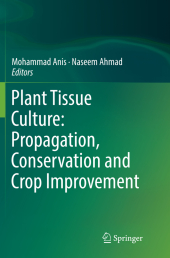 Neuerscheinungen 2018Stand: 2020-02-01 |
Schnellsuche
ISBN/Stichwort/Autor
|
Herderstraße 10
10625 Berlin
Tel.: 030 315 714 16
Fax 030 315 714 14
info@buchspektrum.de |

Naseem Ahmad, Mohammad Anis
(Beteiligte)
Plant Tissue Culture: Propagation, Conservation and Crop Improvement
Herausgegeben von Anis, Mohammad; Ahmad, Naseem
Softcover reprint of the original 1st ed. 2016. 2018. xvii, 621 S. 13 SW-Abb., 66 Farbabb., 54 Tabellen
Verlag/Jahr: SPRINGER, BERLIN; SPRINGER SINGAPORE; SPRINGER 2018
ISBN: 9811094772 (9811094772)
Neue ISBN: 978-9811094774 (9789811094774)
Preis und Lieferzeit: Bitte klicken
This book presents basic concepts, methodologies and applications of biotechnology for the conservation and propagation of aromatic, medicinal and other economic plants. It caters to the needs and challenges of researchers in plant biology, biotechnology, the medical sciences, pharmaceutical biotechnology and pharmacology areas by providing an accessible and cost-effective practical approach to micro-propagation and conservation strategies for plant species. It also includes illustrations describing a complete documentation of the results and research into particular plant species conducted by the authors over the past 5 years.
Plant Biotechnology has been a subject of academic interest for a considerable time. In recent years, it has also become a useful tool in agriculture and medicine, as well as a popular area of biological research. Current economic growth is globally projected in a highly positive manner, but the challenges many countries face with regard to food, feed, malnutrition, infectious diseases, the newly identified life-style diseases, and energy shortages, all of which are worsened by an ever-deteriorating environment, continue to pull the growth digits back. The common thread that connects all of the above challenges is biotechnology, which could provide many answers.
Molecular biology and biotechnology have now become an integral part of tissue culture research. The tremendous impact generated by genetic engineering and consequently of transgenics now allows us to manipulate plant genomes at will. There has indeed been a rapid development in this area with major successes in both developed and developing countries.
The book introduces several new and exciting areas to researchers who are unfamiliar with plant biotechnology and also serves as a review of ongoing research and future directions for scholars. The book highlights numerous methods for in vitro propagation and utilization of techniques in raising transgenics to help readers reproduce the experiments discussed.


